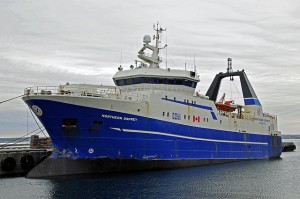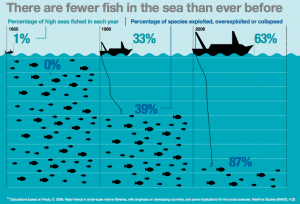Podcast: Play in new window | Download
Subscribe: RSS

When the last factory trawler such as this one returns empty from an empty sea, just go ahead and tun off the lights. (Photo by Dennis Jarvis/Flickr)
The headline in the Washington Post on June 3: “The End of Fish.” Not even the usual weasel question mark at the end to avoid the declarative statement. In mid-June the Global Ocean Commission stated its conclusion that the world’s oceans are on the brink of collapse, offering a Pollyanna-ish eight-point plan for their complete recovery (Step One: Every country in the United Nations agrees to stop plundering the oceans for profit and start working for their recovery. Just give us a call when you’ve done that, and we’ll move on to Step Two.) In late June, Quartz detailed the $27 billion in subsidies from the world’s richest countries to the largest, nost destructive fleets of deep-ocean trawlers, without which they could not sail. The headline on the July 11 cover story in Newsweek: “The Disaster We’ve Wrought on the World’s Oceans May Be Irrevocable.”
Earlier, in May, Michael Snyder writing for the American Dream blog tabulated a list of fresh- and salt-water fish kills around the world in a single month this spring that will set your hair on fire.
It is important to realize that the culprit here is not climate change, although it is making a contribution to the problem. If there were no such thing as climate change, the world’s fish would still be on Death Row, put there by the same endearing qualities and activities that have brought us climate change: boundless greed; massive pollution of air, water and soil; heedless exploitation of natural resources; and political paralysis brought on by injections of currency.
Specifically, three things are wiping out the fish, and there is no reasonable expectation that any of them will abate anytime soon.
1. Ocean Acidification. This first cousin of climate change owes its existence to the massive amounts of carbon dioxide emitted into the air by the burning of fossil fuels. When absorbed by water, CO2 forms an acid, and the accumulation of this acid is lowering the ph of the world’s oceans. (This is commonly called, even by scientists, ocean acidification, but technically it is not. To be called acidic, water would have to be below 7 on the 14-point pH scale, and that has not happened anywhere yet. It’s gone from 8.2 before the Industrial Age to 8.1 now.) It doesn’t sound like much, but this lower alkalinity of seawater has already made it more difficult it is for certain shellfish and coral reefs to build and maintain their structures.
“There’s a profound game-changing event going on in the life of the sea,” says Callum Roberts, a professor of marine conservation at the University of York, England. “The fact is that changes in alkalinity are going to cause massive reorganization of marine life, impacts on marine food webs, productivity, all sorts of things. We’re heading for a car crash here.”
2. Algae Blooms. One form of marine life thrives in warmer, less alkaline water; algae. In these conditions, fed by nitrates from fertilizer washed off of farm fields and city lawns (along with incompletely treated sewage and crap washed off city streets and parking lots in storms), algae populations explode. First they form a thick green slimy mass on top of the water that blocks light from reaching any plants below. Then when it decomposes it sucks all the oxygen out of the water, and sometimes releases toxins into it. One result — enormous dead zones, where nothing lives, at the mouths of most of the world’s rivers. There are more than 400 known dead zones now, the largest, off the mouth of the Mississippi, is as big as Rhode Island.

Graphic by Global Ocean Commission
3. Overfishing. The Census of Marine Life told us four years ago that 90 per cent of the big fish in the ocean are gone, the victims of overfishing. By 2050, other researchers tell us, the ocean will be virtually devoid of edible life. With the callousness of the rich and ignorant, many of the publications that refer to these dire conditions do so as if they represent a limit on our menu choices at fine restaurants. But what we are talking about is the loss of a critical portion of the diets of three billion people. A severing of the food chain. Yet the bulldozing of the ocean floor continues by trawlers that not only vacuum up the remaining edible fish but either kill or destroy the habitat for billions more. None of these engines of death could afford to put to sea were it not for massive subsidies paid by the richest (and, allegedly, smartest) countries on earth.
The bad news is that the fish are dying so fast that any serious effort to help them would have to have started years ago. The good news: in just a few more years, there will no longer be a problem. Because as the narrator on Evening Shade intoned years ago: “Where there is no solution, there is no problem.”
See Also: Billions of Shellfish Die as Ocean Turns to Acid; Report: US Fisheries Crashing; Peak Fish: We’re Running Out of Them, Too; Report: Trawlers Scraping Last Life from Oceans
There should be a revised edition of Moby Dick in which the whale is the true hero, and Captain Ahab the villain.
As I read the book, it’s pretty much like that already. Natural order vs human pathology.
I think that kinda IS the point of Moby Dick already!
Thanks – this is the best, most concise review of the current research I have seen. I love this quote – may have to steal it as equally applicable to ozone pollution: the narrator on Evening Shade intoned years ago: “Where there is no solution, there is no problem.”
To put the destruction of the ocean into historical context, I cannot recommend Farley Mowat’s searing documentary highly enough. This rampage started centuries ago – even before the whaling industry chased them from Nantucket to the high northern Pacific. There is more than one version online – this is the highest quality I could find:
http://witsendnj.blogspot.com/2014/05/sea-of-slaughter.html
It’s actually real interesting what the above article said about algae blooms, because if I remember correctly oil today is formed from the remains of algae millions of years ago. Maybe there’s some kind of cosmic cycle here, whereby the algae blooms of today will end up as new deposits of oil in the earth millions of years in the future; then humanity, which has by then recovered from the present Long Emergency, will start exploiting all the oil again, leading to another jolly round of environmental degradation and another Long Emergency, and so on. :D